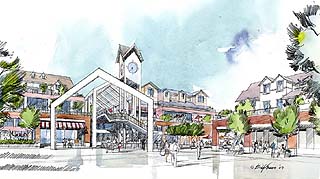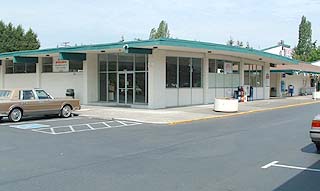
DJC.COM
October 2, 2003
The evolving role of neighborhood retail
Cosmos Development & Administration Corp.

Sketch by Bill Evans
Cosmos Development teamed up with neighbors and government officials to create this vision for Lake Hills Shopping Center’s future. It combines retail with office and housing.
|
Ages ago a “big rock” hit the Earth. Overnight, evolution took a radical turn, dinosaurs became extinct and a door opened for the evolution of humanity.
Today if you want to see T-Rex running down Main Street, sipping from a neighbor’s pool, or snacking on a developer, you have to go to Hollywood.
Contrary to rational thought, not all dinosaurs died off. More than a few survived. Surely many have seen an 8-track, a typewriter, a record, a rotary phone, carbon paper, or even an Edsel hanging around somewhere. With the exception of the Edsel, such creatures live at my house!
Today’s dinosaurs are not all small creatures. In Bellevue, there are at least five colossals that remain at large. Two roam the Lake Hills area and are known to many. As a species they are called “neighborhood retail.” Lake Hills Shopping Center is one such creature.
Shortly after World War II, neighborhood retail evolved from our exodus of city life. Having grown weary of congestion, our fathers got into their cars and drove to the closest strawberry patch, or orchard, and built nice new homes for their families.
Being so far out, however, was inconvenient. There was no place close to buy groceries, medicine or gas. So they evolved the corner grocer into a neighborhood retail creature. More people came and more things were needed.
The idea of suburban expansion was fascinating, so our fathers took the needed things and neatly laid them out apart from each other so that people had to drive to get to them. Before anyone realized, the congestion plague struck again.
Early in this evolution, neighborhood retail like Lake Hills served the community’s needs and was rewarded with patronage. Genetic flaws, however, existed.
Planned for efficiency and circulation, neighborhood retail was built quickly for an era focused on change and disposability. More often than not, they could never make good neighbors. They were bright, noisy and unfriendly. They exposed their backs and service sides to people living around them. They usually had large, unscreened mechanical equipment on their roofs and exposed service docks — both of which kept people awake at night.
Rumors also spread that these creatures swallowed blocks of homes with their insatiable appetite for growth.
In the years that followed, many retail creatures roamed the landscape. They diversified. They took names like strip malls, super malls, regional malls, power centers, town centers and even factory outlets!
Neighborhood retail, the earliest of the suburban creatures, began languishing from the onslaught of available choices. Patronage fell, shopkeepers moved on to where the action was, could be, or thought to be. Income decreased, expenses increased and land values skyrocketed.
These pressures foretold of an inescapable event: economic evolution or extinction.
While this was going on, citizens angered by voracious retail growth in their communities called for restrictions. Neighborhood retail, struggling for survival, called out for more of the same old growth. Sides were taken, lines drawn and disputes fought.

Photo courtesy of Cosmos
Lake Hills Shopping Center is made up of several outdated, detached buildings.
|
Then, without great forethought, both sides did the unthinkable. They unleashed upon themselves a weapon of mass destruction — duct tape.
Duct tape is a seemingly harmless product that has an infinite number of uses, least of which is taping ducts. Law enforcement officers sometimes use it when tying up arrested mobs. It is cheaper than handcuffs. With this intent in mind, duct tape was released to restrain the needed evolution of neighborhood retail.
Legally known as “concomitant zoning agreements,” this duct taping had disastrous consequences for all sides. Read one and you too will begin to fear such things. A concomitant binds the intended victim so tightly to a set of regulations (height, width, uses, diversities, choices, etc.) that it mummifies the victim alive. Under a concomitant, there is no opportunity to address the changing needs of the people you were born to serve.
Hope, however, springs eternal. People armed with knowledge can create solutions. Citizens remembering long ago what neighborhood retail should have really been like began sharing thoughts. They spoke of places to shop locally for those little things that they needed every few days or so. They spoke about places where they could gather and linger; places where larger groups could congregate for local events; places where young and old, tall and short could look to as an icon of their community.
City officials heard, listened and saw that neighborhood retail could fulfill this goal and more. They saw an opportunity to reduce the need to drive to farther away places. They saw an opportunity where additional and different housing types could be made for a growing and varied population. The community and the city wondered why neighborhood retail had not stepped up to address such a lofty goal that no one else could. They had forgotten that many of these creatures had been duct taped into living dinosaurs.
In a bold move, neighbors got together with city officials, community council representatives and yours truly to discuss what could be done to revitalize Lake Hills. They asked us to share risk with them, to be a test case that others could follow. They called themselves the Lake Hills Stakeholder Group. They came with a genuine goal to start anew. They spent two months developing a concept that combines retail, office and residential uses into a distinctive community gathering place. They grappled with past mistakes and inescapable physical and economic realities. They were not afraid to seek new relationships between existing and proposed uses.
In a short time, they crafted an outline for a new zoning type, one that has the potential for improving the quality of our neighborhoods.
Their actions, like that “big rock,” can have an evolutionary impact on neighborhood retail and the community of Lake Hills. Will such a rock be allowed to hit, to shake us all up, and foster new opportunities? Or, should our defensive fears, provided by years of duct taping, blow it out of the sky? What then should we do with neighborhood retail?
Stay tuned and involved, for the answers lie within the East Bellevue Community Council’s chambers and the voices of the community.
Oscar Del Moro, AIA, is senior vice president for Cosmos Development & Administration Corp. He holds a master’s degree in architecture with a certificate in urban design.
Other Stories:
- Seattle calls on ‘Blue Ring’ plan for open space
- Parking lots designed to suck up storm water
- Seattle’s Green Streets ripe for modernization
- Urban sprawl causes waistline sprawl
- Sliver towers squeeze housing into downtown
- The surprising realities of apartment living
- Is Seattle ready to wear the Vancouver style?
- WSU forges urban development partnership
- Living over the store in funky Fremont
- Tight site parking problem? Stack those cars
- Eastside tries filling an affordable housing gap
- Tax increment financing: why it isn’t working here
- Reinventing the residential high-rise
Copyright ©2009 Seattle Daily Journal and DJC.COM.
Comments? Questions? Contact us.